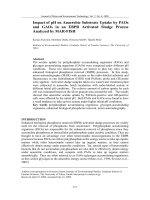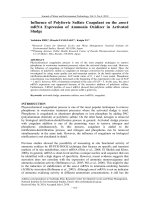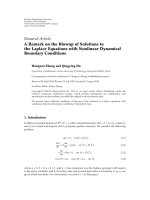Research on manufacturing materials from laterite research on manufacturing materials from laterite to treat wastewater in noodle production villages, noodles in suburban areas of Hanoi
Bạn đang xem bản rút gọn của tài liệu. Xem và tải ngay bản đầy đủ của tài liệu tại đây (270.31 KB, 11 trang )
TRƯỜNG ĐẠI HỌC THỦ ĐÔ H
122
NỘI
RESEARCH ON MANUFACTURING MATERIALS FROM LATERITE
TO TREAT WASTEWATER IN NOODLE PRODUCTION VILLAGES,
NOODLES IN SUBURBAN AREAS OF HANOI
Pham Van Hoan, Ngo Thanh Son, Nguyen Xuan Trinh, Ngo Thi Van Anh
Hanoi Metropolitan University
Abstract: The noodle production village play an important role in the development of the
local economy, as well as preserving the long-standing value of cultural traditions.
However, the recent expansion of production has increased the risk of environmental
pollution, greatly affecting the health of local people as well as landscape and ecology.
Based on the analysis of Phu Do noodle production village wastewater, the study
determined the ability of laterite to treat wastewater, contributing to environmental
protection as well as the sustainable development of region as well as the country in the
near future
Keywords: Laterite, Noodle production, Phu Do, Wastewater, Treatment…
Email:
Received 27 April 2019
Accepted for publication 25 May 2019
1. INTRODUCTION
Among handicraft villages in Hanoi, noodle making village, noodle cake, in the field
of food and food processing, is one of the traditional trade villages that have long been
known. In Hanoi, especially in the suburbs, there are many establishments, households
involved in the production of noodles, noodle cake, providing dozens to hundreds of tons
of vermicelli and noodles every day. Dynamic eating, processing of not only the people of
the capital, but also for neighboring provinces and regions to export to other countries.
However, currently in the city, there are only a few villages producing vermicelli,
noodles with the focus of Phu Do trade village, or Minh Khai craft village (Hoai Duc
district), and other areas of employment, vermicelli, noodle cake is only a small scale of a
few households, such as the village of Mang Trach (Co Loa, Dong Anh), or in Quoc Oai
and Thach That districts.
Due to manual and dispersed production, the treatment of trade village wastewater in
general and noodle production villages in particular is very difficult. This has
TẠP CHÍ KHOA HỌC − SỐ 31/2019
123
consequences for air pollution, pollution of surface water and groundwater, greatly
affecting the health of residents living in the village area [3].
There have been a number of studies evaluating the environment of craft villages,
vermicelli production villages and noodle cakes. However, the treatment of this wastewater
with materials made on laterite has not been studied [1; 2; 5].
To overcome this problem, the study of treatment at the source of noodle production,
noodle cake is necessary and suitable to the local economic conditions.
This article introduces the initial studies using laterite to make materials to treat
wastewater in noodle production villages, pho noodles in Phu Do, Tu Liem, Hanoi.
2. EXPERIMENT
2.1. Survey and assess the status of pollution in craft villages
- Reference documents
- Actual survey
2.2. Research on manufacturing treatment materials from natural sources
(laterite)
Within the scope of research on resources and funding of the topic, the research team
selected the determination of the waste water composition of the village identified by the
surface water system in the production area.
To assess the current status of surface water environment in the village Phu Do, the
research team took samples at 5 locations in 2 phases: October 2018 and February 2019.
Table 1. Sampling location
No
Sample
of waste
water
Places
1
NM1
Nhue River
21°00'48.5"N
105°45'51.8"E
2
NM2
Phu Do pond
21°00'35.5"N
105°46'01.5"E
3
NM3
Nhue River
21°00'37.1N
105°45'44.0"E
4
NM4
Phu Do Lake
21°00'37.7"N
105°45'47.8"E
5
NM5
Phu Do channel
21°00'39.2"N
105°45'49.3"E
Coordinates
The sample collected by the research team was then analyzed at the Center for
Environmental Monitoring and Modeling, University of Science, Hanoi National
University.
TRƯỜNG ĐẠI HỌC THỦ ĐÔ H
124
NỘI
Table 2. Environmental monitoring data of surface water in Phu Do village in phase 1
(October 2018)
Targets
Sample of
waste water
pH
TSS
(mg/l)
BOD5
(mg/l)
COD
(mg/l)
Total Coliform
(MPN/100ml)
NH4+
(mgN/l)
PO43(mgP/l)
MN1
6,11
227
4213
5013
170000
68.88
16,03
MN2
5,47
394
5656
8666
22000
85,12
16,19
MN3
6,26
474
5506
6406
900000
154,02
29,93
MN4
6,59
55
3473
5010
8000
39,76
8,48
MN5
6,1
96
108,3
278
300000
93,52
0,08
QCVN 08:
2008/BTNMT
5,5 – 9
50
15
30
7500
0,5
0,3
The analytical results show that, in addition to the target of pH of organic substances
at the monitoring positions, it is many times higher than the regulations of QCVN 08: 2008
/ BTNMT national technical regulations on quality. surface water. COD content is 9.3 288.87 times higher; BOD is 7.22 - 377.1 times higher; The concentration of TSS is 1.1 9.48 times higher, the total Coliform is 1.1 - 120 times higher; NH4 + content is 79.53 308.04 times higher, PO43- content is 28. 27 - 99.77 times higher than Column B1
(regulating water quality for irrigation or other purposes) Other uses) of QCVN 08: 2008 /
BTNMT.
The presence of high concentrations of NH4 + and PO43- has caused the water
environment in the ponds to be enriched, the algae thrive, causing the phenomenon of
water blooming, stinking water.
Table 3. Environmental monitoring data of surface water in Phu Do trade village, phase 2
(February 2019)
Targets
Sample of
waste water
pH
TSS
(mg/l)
BOD5
(mg/l)
COD
(mg/l)
Total Coliform
(MPN/100ml)
NH4+
(mgN/l)
PO43(mgP/l)
MN1
6,0
211
3275
3202
150230
57.88
16,03
MN2
5,1
312
4423
6533
20234
68.11
12.34
MN3
5,8
212
5237
5328
670564
134,02
13,7
MN4
6,1
62
2138
4231
7008
42.23
8,48
MN5
5,9
78
114,2
250
26900
84.56
0,05
QCVN 08:
2008/BTNMT
5,5 – 9
50
15
30
7500
0,5
0,3
TẠP CHÍ KHOA HỌC − SỐ 31/2019
125
Analysis results show that, in addition to the target of pH of organic matters in the lake
is many times higher than the regulations of QCVN 08: 2008 / BTNMT national technical
regulations on surface water quality. COD content is 8.33 - 217.77 times higher; BOD is
7.61 - 349.1 times higher; TSS content is 1.24 - 4.22 times higher.
Total Coliform: Particularly, the parameter content at the monitoring point NM4 =
7008 is within the permitted limit of QCVN08: 2008 / BTNMT. Total Coliform content at
positions NM1 - 2- 3 - 5 is higher than the permitted limit of QCVN08: 2008 / BTNMT
from 2.7 to 89.41 times. ; NH4 + content is 79.53 - 308.04 times higher.
The concentration of PO43- is 28.3 - 53.43 times higher than that of QCVN 08: 2008 /
BTNMT (except for the position NM5 of PO43- within the permitted limit of the method).
The value of surface water environmental monitoring parameters through the two
assessments is shown on the charts below.
pH
10
8
October
Đợt
1 2018
6
February
Đợt
2 2019
4
QCVN08:2008/BTNMT
2
QCVN8:2008/BTNMT
0
MN1
MN2
MN3
MN4
MN5
Figure 1. pH at two monitoring sites
500
TSS (mg/l)
450
400
350
October
2018
Đợt
1
300
February
2019
Đợt
2
250
200
QCVN08:2008/BTNMT
150
100
50
0
MN1
MN2
MN3
MN4
MN5
Figure 2. TSS at 2 monitoring points
TRƯỜNG ĐẠI HỌC THỦ ĐÔ H
126
NỘI
pH value of surface water environment ranged from 5.5 - 7.0 within the permitted
limit of QCVN 08: 2008 / BTNMT national technical standards for surface water quality.
The value of the second phase pH decreased compared to the first phase.
TSS content in water tends to decrease through 2 monitoring periods. However, the
TSS content in both monitoring periods in all sampling locations exceeded the permitted
limit of QCVN 08: 2008 / BTNMT.
6000
BOD5 (mg/l)
5000
4000
October
2018
Đợt
1
3000
February
2019
Đợt
2
2000
QCVN08:2008/BTNMT
1000
0
MN1
MN2
MN3
MN4
MN5
Figure 3. BOD5 at 2 monitoring points
BOD5 content in the regional water environment exceeds the permitted limits of
QCVN 08: 2009 / BTNMT many times and tends to decrease.
10000
COD (mg/l)
9000
8000
7000
October
2018
Đợt
1
6000
5000
February
2019
Đợt
2
4000
QCVN08:2008/BTNMT
3000
2000
1000
0
MN1
MN2
MN3
MN4
MN5
Figure 4. COD at 2 monitoring points.
TẠP CHÍ KHOA HỌC − SỐ 31/2019
127
Like BOD5, the COD content in the water in the local Phu Do village area is very
high, exceeding the permitted standard of QCNV08: 2008 / BTNMT on surface water
quality and tends to decrease.
Tổng Coliform (MPN/100ml)
1000000
900000
800000
700000
600000
500000
400000
300000
200000
100000
0
October
2018
Đợt
1
February
2019
Đợt
2
QCVN08:2008/BTNMT
MN1
MN2
MN3
MN4
MN5
Figure 5. Total value of Coliform at 2 monitoring points
The total value of Coliform in the environment in the area tends to decrease but
not significantly. The content in the positions MN1, MN3, MN5 is very high in excess of
the permitted limit of QCVN 08: 2008 / BTNMT many times. Particularly, position MN4
in phase 2 has a total Coliform content below the permitted limit of surface water quality
standards.
180
NH4+ (mg/l)
160
140
120
October 2018
Đợt 1
100
February
2019
Đợt
2
80
QCVN08:2008/BTNMT
60
40
20
0
MN1
MN2
MN3
MN4
MN5
Figure 6. NH4+ at 2 monitoring points
TRƯỜNG ĐẠI HỌC THỦ ĐÔ H
128
NỘI
Based on the chart, it is easy to see that the content of ammonium in the country tends
to decrease, except for the MN4 point, but it is not significant. The content of ammonium
in water at two monitoring periods is very high, exceeding the permitted limit of QCVN
08: 2008 / BTNMT.
35
PO43- (mg/l)
30
25
October
2018
Đợt
1
20
Đợt
2
February
2019
15
QCVN08:2008/BTNMT
10
5
0
MN1
MN2
MN3
MN4
MN5
Figure 7. PO43- in surface water at 2 monitoring points
The concentration of PO43- in surface water in Phu Do vermicelli production village
tended to decrease slightly through 2 monitoring periods. However, the content of PO43in both batches is very high, exceeding the permitted limit of QCVN 08: 2008 / BTNMT
on surface water quality.
3.3. Fabrication of laterite materials is taken from Thach That district, Hanoi
and processed according to the following process
Laterite
Smash,
sift
through
2mn sieve
Wash and soak
distilled water 2
times (1 hour); Add
additives
Create
tablets, size
0.1 - 0.2 cm
Figure 8. Material made of laterite (M1)
Cook at
0
900 C for 6
hours
TẠP CHÍ KHOA HỌC − SỐ 31/2019
129
3.4. Examine the ability of materials in wastewater treatment of vermicelli
production villages, pho noodles
Waste
water
Clarifier
1
Clarifier
2
Filter
tank 2
(M1)
Filter
tank 1
(sand)
Filter
tank 3
(M1)
Waste
output
Figure 9. Layout diagram of wastewater treatment experiment
To determine the role of materials (M1), water samples through settling tanks 1, 2 and
filter tank 1 were taken out to assess color and odor.
By observation, waste water through settling tanks and filter tanks 1 still has an
unpleasant odor and is slightly turbid. Because sand only retains insoluble suspended
matter, the removal of dissolved substances is entirely due to the material made from
laterite (M1).
Results of quality evaluations of waste water after treatment are as follows.
3.4.1. Feelings
Odor: the original sour smell has been exhausted, indicating that evaporation solvents
have been removed;
Color: clear, demonstrating that colored or suspended solids components have been
removed.
3.4.2. Other soluble ingredients
Adsorption efficiency (%) is calculated by the following formula:
Adsorption (%) = (Ci – Co) / Ci x 100
In which Ci: the input concentration of the target
Co: output concentration
The indicators after analysis are shown as follows:
a. Target of TSS (Total suspended solid content)
Table 4. TSS index and processing efficiency
TSS (mg/l)
Sample of waste
water
Input
Output
processing
efficiency
MN1
277
45
84%
MN2
394
47
88%
MN3
475
62
87%
TRƯỜNG ĐẠI HỌC THỦ ĐÔ H
130
NỘI
Thus, the wastewater treatment system for vermicelli, noodles with laterite material is
proposed, capable of handling suspended solids with an average efficiency of 86%. The
content of TSS in the outlet water is also approximately the permitted limit according to
QCVN
b. BOD5 index (Biochemical oxygen demand)
Table 5. BOD5 index and processing performance
Sample of waste
water
BOD5 (mg/l)
processing efficiency
Input
Output
MN1
4213
1023
75%
MN2
5656
1540
72%
MN3
5506
1450
73%
Treatment system with laterite material as proposed, has the ability to handle BOD5
with an average efficiency of 73%. However, the amount of BOD5 in the output water is
still very high, far exceeding QCVN many times.
c. COD criteria (Chemical oxygen demand)
Table 6. COD index and processing efficiency
COD (mg/l)
Sample of waste
water
Input
Output
MN1
5013
1290
74%
MN2
8666
2020
76%
MN3
6406
1415
78%
processing efficiency
The system has the ability to handle COD, the average efficiency is 76%, but the COD
content is still very large, far exceeding QCVN many times.
d. Total coliform
Table 7. Coliform index and treatment performance
Tổng coliform (MPN/100ml)
Sample of waste
water
Input
Output
MN1
150230
29540
80%
MN3
670564
102430
84%
MN5
26900
5400
80%
processing efficiency
TẠP CHÍ KHOA HỌC − SỐ 31/2019
131
The ability to treat coliform of the proposed system is relatively high, the average
yield is 81%. However, at times when the total coliform is abnormally high, the output
index is still very large, exceeding the QCVN.
e. NH4+
Table 8. NH4 + index and processing efficiency
Sample of waste
water
NH4+
processing efficiency
Input
Output
MN2
85,12
12,04
85%
MN3
154,02
19,46
87%
MN5
93,52
14.01
85%
The proposed system is capable of handling NH4 + Ion in a sample of vermicelli
wastewater, average performance reaches 85%. However, the amount of ammonium ion in
the output water is still higher than the permitted level according to QCVN.
g. PO43Table 9. PO43- index and processing performance
PO43-
Sample of waste
water
Input
Output
processing
performance
MN1
16,03
2,4
85%
MN2
16,19
1,96
88%
MN3
29,93
3,06
89%
Thus, the wastewater treatment system has the ability to process ion PO43-, the
processing efficiency is relatively high, averaging 87%.
4. CONCLUSION
The water treatment system proposed with mechanical methods combined with laterite
materials to treat wastewater of the vermicelli production village, Phu Do is the deodorant
and color. Using materials to treat waste water from laterite - an available and cheap
materials is a promising research direction that needs further study.
However, the treatment is not really thorough, the processing efficiency has not really
met the expectations, need to be studied further.
132
TRƯỜNG ĐẠI HỌC THỦ ĐÔ H
NỘI
REFERENCES
1.
2.
3.
4.
5.
6.
Ministry of Natural Resources and Environment (2013), National Environmental
Status Report.
Circular 46/2011/ TT-BTNMT, December 26, 2011 of the Ministry of Natural
Resources and Environment promulgating Regulations on environmental protection of
craft villages.
Sub-Department of Environmental Protection (2013), Specialized report on the
current situation of natural environment, topography and socio-economic conditions,
Production and technology of Phu Do noodle village, Hanoi.
Dang Kim Chi, Nguyen Ngoc Lan, Tran Le Minh (2005), Vietnam Craft Village and
Environment, Science and Technology Publishing House.
Le Ngoc Anh (2013), Graduation project: Applying DPSIR model in assessing the
current state of water environment in Bai Do trade village, Tri Thuy commune, Phu
Xuyen district, Hanoi.
QCVN 08: 2008 / BTNMT National technical regulation on surface water quality.
NGHIÊN CỨU CHẾ TẠO VẬT LIỆU XỬ LÍ NƯỚC THẢI LÀNG
NGHỀ SẢN XUẤT BÚN, BÁNH PHỞ TẠI KHU VỰC NGOẠI
THÀNH HÀ NỘI 55TỪ ĐÁ ONG
Tóm tắ
tắt: Làng sản xuất bún, bánh phở đóng một vai trò quan trọng trong sự phát triển
của nền kinh tế địa phương, cũng như bảo tồn giá trị lâu đời của truyền thống văn hóa.
Tuy nhiên, việc mở rộng sản xuất gần đây đã làm tăng nguy cơ ô nhiễm môi trường, ảnh
hưởng lớn đến sức khỏe của người dân địa phương cũng như cảnh quan và sinh thái.
Dựa trên phân tích nước thải làng sản xuất mì Phú Đô, nghiên cứu đã xác định khả năng
xử lý nước thải của đá ong, góp phần bảo vệ môi trường, đóng góp sự phát triển bền
vững của khu vực cũng như đất nước trong tương lai.
Từ khóa:
khóa Laterit (Đá ong), sản xuất bún, Phú Đô, nước thải, xử lý…









